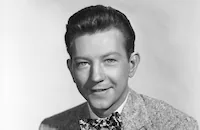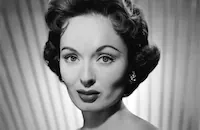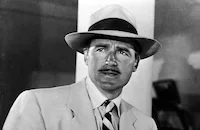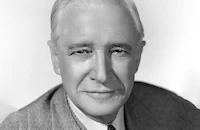Chip Off the Old Block
Cast & Crew
Charles Lamont
Donald O'connor
Peggy Ryan
Ann Blyth
Helen Vinson
Helen Broderick
Film Details
Technical Specs

Synopsis
After writing, directing and starring in the annual musical show at the Sperling Naval Academy, cadet Donald Corrigan is brought before Dean Manning for his many shenanigans. Rather than expelling the teenager, Manning sends Donald home on an extended leave, stating that he may return once he corrects his behavior. Donald meets Glory Marlow III on the train to New York City and becomes immediately smitten. Glory III, who was reared in Hawaii by her aunt and uncle, tells Donald that she is going to New York to live with her mother and grandmother, two famous actresses of the musical theater. Unknown to Glory III, however, is the fact that her mother has just announced her retirement. When her producers, Blaney Wright and Henry McHugh, suggest that Glory III take her place in their new production, Glory, Jr. refuses, as she is intent on keeping her daughter out of the theater. Upon arriving in New York, Donald is met at the train station by love-struck Peggy Flaherty, who causes the jealous Glory III to break her date with Donald. When Glory III tells her mother and grandmother what happened, they tell her about the "Corrigan curse," as they too had fallen in love, then lost, both Donald's father and grandfather. Donald still calls on Glory III that night, but she, bowing to two generations of advice, refuses to see him. The next day, Donald meets with Peggy, and she agrees to square things with Glory III if he agrees to help her audition for some Broadway plays. Glory, however, having ordered Quentin, her butler, to tell Glory III that Donald has left town, impersonates her granddaughter on the phone and tells Donald that Glory III is engaged. The two teenagers, though, run into each other on the streets of New York, and learn about her grandmother's deception. Glory III then invites Donald and Peggy to her recital that night, much to her mother and grandmother's chagrin. Peggy uses the recital as an opportunity to audition for the theatrical producers in attendance, but Blaney and Henry leave before she and Donald perform their number. Glory III is later offered the lead in the producers' new play, but she refuses, stating that she plans to spend her time working for Chinese war relief and other charities. Donald convinces her to do the play, however, on the condition that all profits be donated to those same charities. Later, Donald's father, Commander Judd Corrigan, returns home, and while eavesdropping on him, Donald and Peggy mistakenly assume that he is a German spy when they hear him discussing plans for Donald's birthday present. After learning that Donald is dating Glory III, Judd goes with his son to Glory III's rehearsal, where he tells Glory, Jr. that he is still in love with her. That night, Donald and Peggy unsuccessfully attempt to steal Judd's blueprints from Scheffer, a German-American sailboat builder. Judd then orders Donald to return to Sperling. Just as her show, The Third Glory , is about to open on Broadway, Glory III insists that they perform their final rehearsal at the Academy. Aware that his father is meeting with Scheffer at a nearby boat house, Donald and his cadet friends abduct the boat builder, only to discover that the "spy plans" are the blueprints to Donald's birthday present. Peggy then connives to get Donald to appear with her in the final rehearsal, but he still ends up in the arms of Glory III when they walk offstage together.

Director
Charles Lamont
Cast

Donald O'connor

Peggy Ryan

Ann Blyth

Helen Vinson

Helen Broderick

Arthur Treacher

Patric Knowles

J. Edward Bromberg

Ernest Truex

Minna Gombell

Samuel S. Hinds

Irving Bacon
Joel Kupperman
Frank Wilcox
Bobby Scheerer

Jerry Antes
Harold Bell
Jack Coffey
Dante Dipaolo
Lowell Mcpeek
Lou Payetta
Pat Phelan
Cal Rothenberg
George Rowland
Jerry Singer
Ronald Stanton
Jean Davis
Dorothy Webb
Shirley Mills
Peggy Brant
Elaine Campbell
Arlyne Gladden
Verda Jenkins
Irma Jeter
Lu Anne Jones
Iris Kirksey
Connie Roberts
Barbara Strong
Leon Belasco

Mantan Moreland
Arthur Loft
Gladys Blake
Eddie Bruce
Dorothy Granger
Vernon Dent
Sidney Miller
George Reed
Jessie Tai Sing
Dorothy Babb
Joe Mcguinness
Harry Harvey Jr.
Bill Henderson
Jack Bell
Billy Bestor
John Truel
Robert Coleman
Walter Carter
Jack Gardner
Pat Dillon
Jack Lindquist
Bruce Bilson
Crew
Robert Arthur
Bernard B. Brown
Lew Brown
Bernard W. Burton
Charles Carroll
Eugene Conrad
Eugene Conrad
William Crago
Louis Da Pron
Ralph M. Delacy
R. A. Gausman
John B. Goodman
Ray Henderson
Inez James
Charles Maynard
Sidney Miller
Charles Previn
E. R. Robinson
Larry Russell
Milton Schwarzwald
Milton Schwarzwald
Grace Shannon
Frank Skinner
Charles Tobias
Leo Townsend
Ernest Truex
Charles Van Enger
Vera West
Mack Wright

Film Details
Technical Specs

Articles
Peggy Ryan (1924-2004)
Born Margaret O'Rene Ryan on August 28, 1924, in Long Beach, California, Ryan began dancing professionally as a toddler in her parents' vaudeville act, the Dancing Ryans, and was discovered by George Murphy when she was 12. Murphy arranged for young Peggy to dance with him in the Universal musical Top of the Town (1937). She would go on to make a few more film appearances over the next few years - the most striking of which as a starving, homeless girl in John Ford's The Grapes of Wrath (1940) - yet for the most part, she was hardly noticeable apart from a few dance numbers.
Her luck changed when Universal cast her opposite another teenage hoofer, Donald O'Connor in What's Cookin'? (1942). From then on, they teamed in a series of innocuous musicals that were low on production values, but high on youthful pluck. Just check out some of their titles: Private Buckaroo, Give Out, Sisters!, Get Hep to Love (all 1942); Top Man, Mr. Big (both 1943); Chip Off the Old Block, This Is the Life, and Bowery to Broadway (all 1944). They may have not been high art, but jitterbuggin' kids loved it, and given the low investment Universal put into these pictures, they turned quite the profit.
Her career slowed down after the war. In 1945, she married songwriter James Cross, and didn't return to films until 1949, when she made two minor musicals that year: Shamrock Hill, There's a Girl in My Heart. She divorced Cross in 1952 and met her second husband, dancer Ray McDonald, in her final film appearance, a forgettable musical with Mickey Rooney, All Ashore (1953). Tragically, McDonald died in 1957 after a food choking incident, and the following year, Ryan moved to Honolulu after marrying her third husband, Honolulu Advertiser columnist Eddie Sherman. She kept herself busy teaching dance classes at the University of Hawaii, but in 1969, she found herself back in front of the camera as Jenny Sherman, secretary to Detective Steve McGarrett (Jack Lord) on the long-running show Hawaii Five-O,. She played the role for seven years, remaining until 1976.
Eventually, Ryan relocated with her husband to Las Vegas, where for the last few years, she was teaching tap dancing to a whole new generation of hoofers. She is survived by her son, Shawn; daughter Kerry; and five grandchildren.
by Michael T. Toole

Peggy Ryan (1924-2004)
Quotes
Trivia
Notes
The working title of this film was The Third Glory. Hollywood Reporter news items and production charts include Walter Catlett in the cast, but he did not appear in the film. According to the Variety review, actor Donald O'Connor was inducted into the U.S. Army the same week this film was released. This marked the film debut of sixteen-year-old actress Ann Blyth, who had previously appeared on Broadway in the play Watch on the Rhine.














